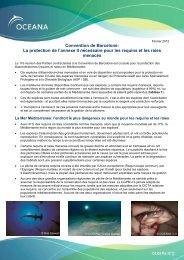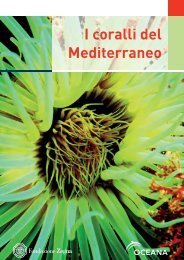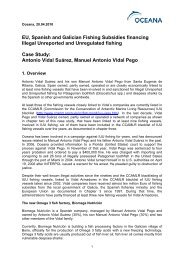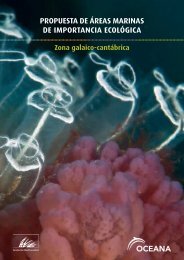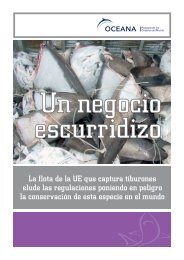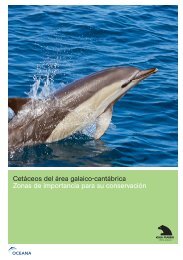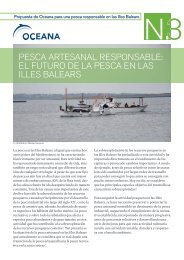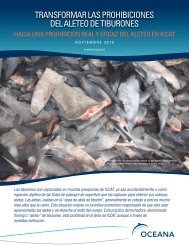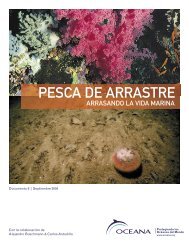Download - Oceana
Download - Oceana
Download - Oceana
Create successful ePaper yourself
Turn your PDF publications into a flip-book with our unique Google optimized e-Paper software.
2. Phakellia ventilabrum aggregation on circalittoral rocky bottom<br />
DESCRIPTION: Aggregations of Phakellia ventilabrum are formed along the whole Cantabrian coast in<br />
great variety of different environments. Regarding depth, they are distributed along a large bathymetric<br />
range. OCEANA found them from 45 m to 190 m., both on flat and steep seabed and with vertical walls.<br />
Fields have medium and low density in front of Cantabria and Euskadi, while aggregations show higher<br />
density on the Galician coast.<br />
On the shallowest area (45-120 m) of distribution, fields are predominant on abrupt rocky substrate with<br />
little sedimentation. On some areas, the rock is covered by Corynactis viridis or brachiopods. It is also<br />
common to find these aggregations mixed with relevant facies of sponges (Axinella spp., Cliona celata) or<br />
gorgonians gardens (Eunicella verrucosa).<br />
Making part of this community, other species such as Artemisina transiens, Tedania urgorrii, Dendrophyllia<br />
cornigera, Holothuria forskali and Serranus cabrilla are also frequent.<br />
However, on deeper areas, between 90 and 190 m, these fields occur on more sedimentary seabed, in<br />
many occasions covered by a compact sediment layer, where some rocks emerge. Along with sponges<br />
(Phakellia ventilabrum), the most representative species in the community are Dendrophyllia cornigera<br />
and Bonellia viridis, as well as echinoderms (Antedon bifida, Echinus esculentus, Holothuria forskali,<br />
Leptometra celtica and Ophiothrix fragilis) in some areas. Leptometra celtica and Ophiothrix fragilis can<br />
generate very long facies in some areas.<br />
Sponges (Artemisina transiens, cf. Stylocordyla sp., Tedania sp. and other unidentified demospongiae)<br />
are the other predominant groups of this community, where mixed areas with Phakellia ventilabrum can be<br />
created, as is the case of Artemisina transiens and cf. Stylocordyla sp.<br />
We must also highlight the mixed fields of Phakellia ventilabrum with Dendrophyllia cornigera and/or<br />
Artemisina transiens that are created along the Cantabrian littoral, mainly on the western area.<br />
DEPTH: 345- 350 m<br />
TYPE OF SUBSTRATE: These aggregations are developed on rocky substrate, both on seabeds with no<br />
sediments and on very sedimentary seabeds.<br />
TYPICAL FAUNA OF THE COMMUNITY<br />
PORIFERA<br />
Artemisina transiens Pachymatisma johnstonia<br />
Axinella polypoides Guitarra solorzanoi<br />
Axinella dissimilis Haliclona cinerea<br />
Clathrina coriacea Petrosia ficiformis<br />
Cliona celata Cf. Stylocordyla sp.<br />
Desmacidon fruticosum Cf. Petrosia crassa<br />
Halichondria panicea Tedania urgorrii<br />
Pachastrella sp. Tedania sp.<br />
CNIDARIA<br />
Acanthogorgia hirsuta Epizoanthus sp.<br />
Alcyonium glomeratum Eunicella verrucosa<br />
Alcyonium sp. Gymnangium montagui<br />
Caryophyllia sp. Paramuricea grayi<br />
Cerianthus membranaceus Parantipathes hirondelle<br />
Corynactis viridis Parazoanthus anguicomus<br />
56



